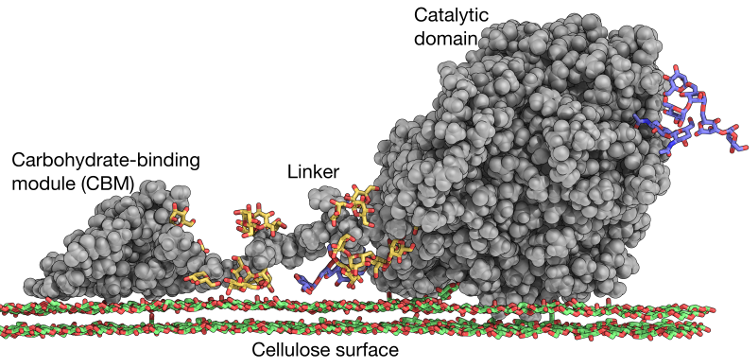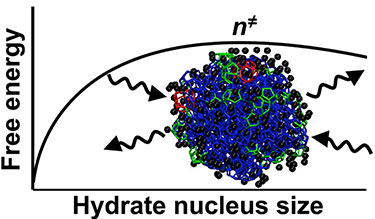
Brandon Knott
Group Research Manager II-Chemical Engineering
Research Interests
-
Molecular mechanisms of cellulose-degrading enzymes
-
Structure-function relationships of biomass-derived polymers
-
Structure-function relationships in glycoside hydrolases
-
Methane clathrate hydrates formation
Molecular Mechanisms of Cellulose-Degrading Enzymes

The degradation of cellulose by glycoside hydrolase enzymes has been studied more extensively than its biosynthesis, but important questions still remain. Cellobiohydrolases are cellulase enzymes that processively hydrolyze individual cellulose chains, producing cellobiose (a dimer of glucose). Cellobiohydrolases complete a "processive cycle" repeatedly before disengaging from the chain; this cycle includes several steps, which are extremely difficult to differentiate experimentally. We employ advanced molecular simulation tools to study each step individually (including the chemical reaction and cellulose processivity). For example, we study Trichoderma reesei Cel7A (see figure), the most prevalent component of industrial cellulase mixtures and an effective model system for studying processive cellulase enzymes. Taken together with past studies, our results shed light on rate-limiting steps in cellobiohydrolases, providing potential protein engineering targets.
Structure-Function Relationships of Biomass-Derived Polymers

Utilizing molecular dynamics simulations of various flavors, we seek to accelerate the design of novel biomass-derived polymers. Primarily, we do this in two basic ways: (1) by explaining novel behavior of bio-derived polymers observed in the lab and (2) by suggesting new formulations for bio-derived polymers to be synthesized in the lab. In both amorphous and crystalline systems, we examine barrier properties, thermal properties, and mechanical properties.
Structure-Function Relationships in Glycoside Hydrolases

As detailed in our group's recent Chemical Reviews article, we are keenly interested in developing and understanding structure-function relationships in enzymes important to the breakdown of biomass. These relationships can help to guide protein engineering efforts. Comparing cellobiohydrolases (CBHs) and endoglucanases (EGs) provides one example of this type of relationship (see figure). Generally speaking, the primary structural difference between a CBH and an EG is the loops that cover the enzymes active site. This structural difference has been shown to have a dramatic consequence for the function of these enzymes, including their processive ability (i.e., the number of bonds they hydrolyze before dissociating from a cellulose chain) and their probability of endo-initiation (i.e., hydrolyzing a bond in the interior of the cellulose chain, rather than at the chain end). In addition to T. reesei Cel7A (a CBH), also shown are Phanerochaete chrysosporium Cel7D (a CBH with less extensive loops than TrCel7A) and endoglucanases TrCel5A and TrCel12A.
Methane Clathrate Hydrates Formation

Clathrate hydrates are multi-component crystalline inclusion compounds of hydrogen-bonded water "cages" surrounding a hydrophobic guest molecule. Methane hydrates are a particularly important example, as they occur in vast natural reservoirs around the globe and have relevance to global climate trends, carbon dioxide sequestration, and gas storage and transportation. Perhaps most significantly, they can threaten oil and natural gas production by blocking pipelines and exacerbating oil-well blowouts. With collaborators at the Center for Hydrate Research at the Colorado School of Mines, we have utilized molecular simulation to investigate the molecular mechanism by which these compounds form. The figure shows a schematic representation of the nucleation of a hydrates nucleus. Red, green, and blue lines represent hydrogen bonds between water molecules in different types of cages surrounding methane molecules (black spheres).
Education
-
Ph.D., Chemical Engineering, University of California, Santa Barbara, 2012
-
B.S., Chemical Engineering, Arizona State University, 2007
Professional Experience
-
Staff Engineer, NREL, Biosciences Center, 2017–present
-
Staff Engineer, NREL, National Bioenergy Center (NBC), 2015–2017
-
Postdoctoral Researcher, NREL, NBC, 2014–2015
-
Director's Postdoctoral Fellow, NREL, NBC, 2012–2014
-
Graduate Intern, The Boeing Company, 2011
-
Undergraduate Intern, Freescale Semiconductor, 2006
Featured Publications
-
"Engineering enhanced cellobiohydrolase activity," Nature Communications (2018)
-
"Consideration of the Aluminum Distribution in Zeolites in Theoretical and Experimental Catalysis Research," ACS Catalysis (2017)
-
"Distinct roles of N- and O-glycans in cellulase activity and stability," PNAS (2017)
-
"Aqueous stream characterization from biomass fast pyrolysis and catalytic fast pyrolysis," ACS Sustainable Chemistry & Engineering (2016)
-
"Biochemical and Structural Characterizations of Two Dictyostelium Cellobiohydrolases from the Amoebozoa Kingdom Reveal a High Level of Conservation between Distant Phylogenetic Trees of Life," Applied and Environmental Microbiology (2016)
-
"Simulations of cellulose translocation in the bacterial cellulose synthase suggest a regulatory mechanism for the dimeric structure of cellulose," Chemical Science (2016)
-
"Who's on base? Revealing the catalytic mechanism of inverting family 6 glycoside hydrolases," Chemical Science (2016)
-
"Biochemical and Structural Characterizations of Two Dictyostelium Cellobiohydrolases from the Amoebozoa Kingdom Reveal a High Level of Conservation between Distant Phylogenetic Trees of Life," Applied and Environmental Microbiology (2016)
-
"Fungal Cellulases," Chemical Reviews (2015)
-
"Nucleation rate analysis of methane hydrate from molecular dynamics simulations," Faraday Discussions (2015)
-
"Reaction coordinate of incipient methane clathrate hydrate nucleation," The Journal of Physical Chemistry B (2014)
-
"Carbohydrate-protein interactions that drive processive polysaccharide translocation in enzymes revealed from a computational study of cellobiohydrolase processivity," Journal of the American Chemical Society (2014)
-
"Towards a molecular-level theory of carbohydrate processivity in glycoside hydrolases," Current Opinion in Biotechnology (2014)
-
"The mechanism of cellulose hydrolysis by a two-step, retaining cellobiohydrolase elucidated by structural and transition path sampling studies," Journal of the American Chemical Society (2013)
-
"Homogeneous nucleation of methane hydrates: unrealistic under realistic conditions," Journal of the American Chemical Society (2012)
-
"Bubbles, crystals, and laser - induced nucleation," Journal of Chemical Physics (2011)
-
"A simulation test of the optical Kerr mechanism for laser-induced nucleation," Journal of Chemical Physics (2011)
-
"Estimating diffusivity along a reaction coordinate in the high friction limit: Insights on pulse times in laser-induced nucleation," Journal of Chemical Physics (2009)
View all NREL Publications for Brandon Knott.
Share

